Key takeaways:
- Tourist traps often offer misleading attractions with inflated prices, leading travelers to miss genuine local experiences.
- Researching destinations in advance and utilizing local advice can unveil hidden gems that offer authentic cultural experiences.
- Key characteristics of tourist traps include high-pressure sales tactics, homogenized experiences, and exorbitant prices for low-value attractions.
- Engaging with locals and observing crowds can help travelers identify and avoid tourist traps while discovering more meaningful experiences.
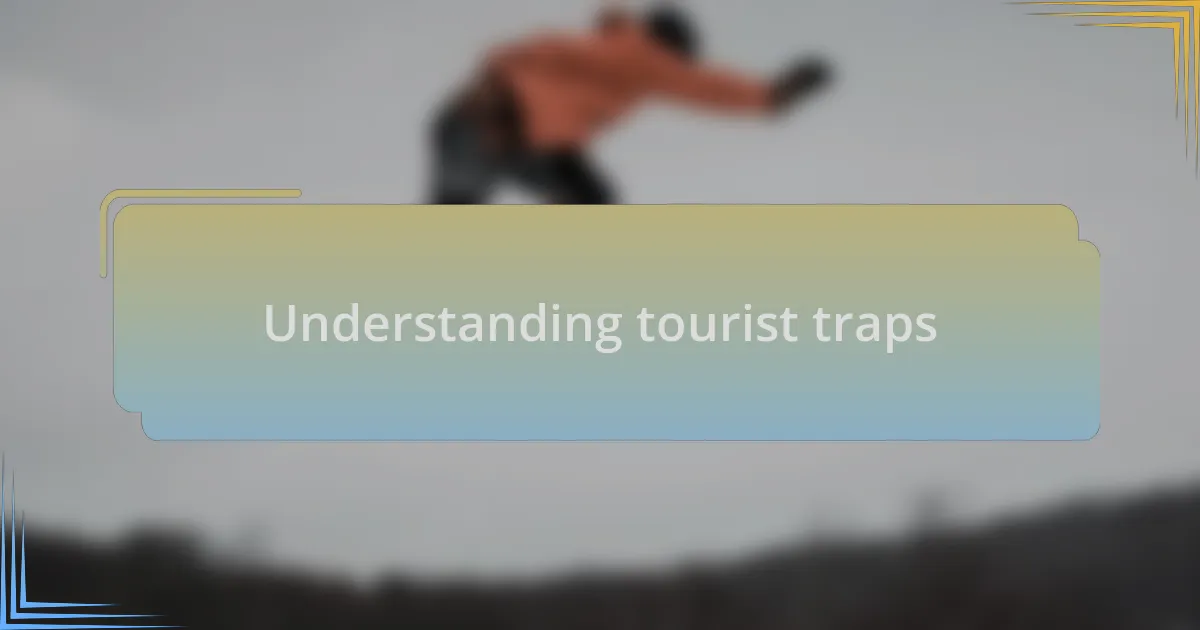
Understanding tourist traps
Tourist traps often lure visitors in with bright lights and enticing promises, masking the inflated prices and mediocre experiences lurking underneath. I remember standing in front of a well-advertised restaurant in a popular tourist area, only to realize that the food was nothing compared to what I had tasted at a local eatery a few blocks away. It left me wondering: how many incredible hidden gems are we bypassing in favor of flashy tourist spots?
Understanding the psychology behind tourist traps can be quite enlightening. They capitalize on our desire for convenience and safety, often drawing us in by suggesting that what’s familiar must be worthwhile. In my travels, I’ve been caught up in the hype, thinking, “Everyone is here, so it must be good!” Yet, those moments of reflection taught me that the crowd doesn’t always signify quality or authenticity.
Moreover, many tourist traps thrive on our fear of missing out (FOMO). I once felt pressured to take a certain guided tour that everyone seemed to rave about, only to find myself trapped in the chaos of a large group, wondering if my time could’ve been better spent exploring independently. Have you ever felt that way? These experiences have shown me the importance of stepping back and questioning the allure of these commercialized attractions before diving in.
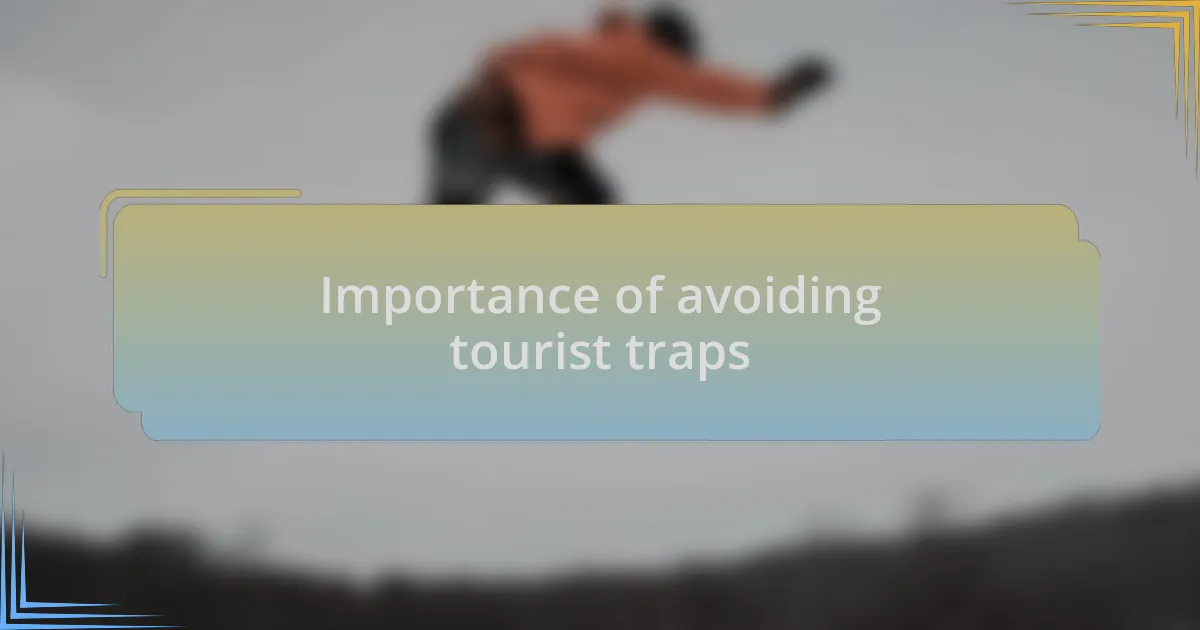
Importance of avoiding tourist traps
Avoiding tourist traps is essential to fully enjoy one’s travel experience and to truly immerse oneself in the local culture. I recall a time when I opted for a well-promoted guided tour in a bustling city, only to be corralled through generic attractions with little time to explore the unique, off-the-beaten-path sites that captured the essence of the destination. Isn’t it frustrating to think that you might miss out on those authentic experiences because of a shiny brochure?
By steering clear of these pitfalls, you open yourself up to discovering authentic local cuisine, art, and stories that resonate with the community’s spirit. I once stumbled across an unassuming café while wandering through a quiet street. The owner was more than willing to share their story and the recipe for their signature dish, which turned out to be a highlight of my trip. Have you ever had a moment that felt far more special than any tourist attraction?
Moreover, avoiding tourist traps helps you save money and spend those resources on genuine experiences. Instead of being lured into overpriced shops or restaurants, I’ve learned to seek out local markets and smaller eateries where prices reflect the true value of what you’re consuming. It’s about investing in experiences that nourish your soul, rather than spending on mere attractions. What if you could return home with memories that feel real and enriching rather than just nice pictures for a social media post?
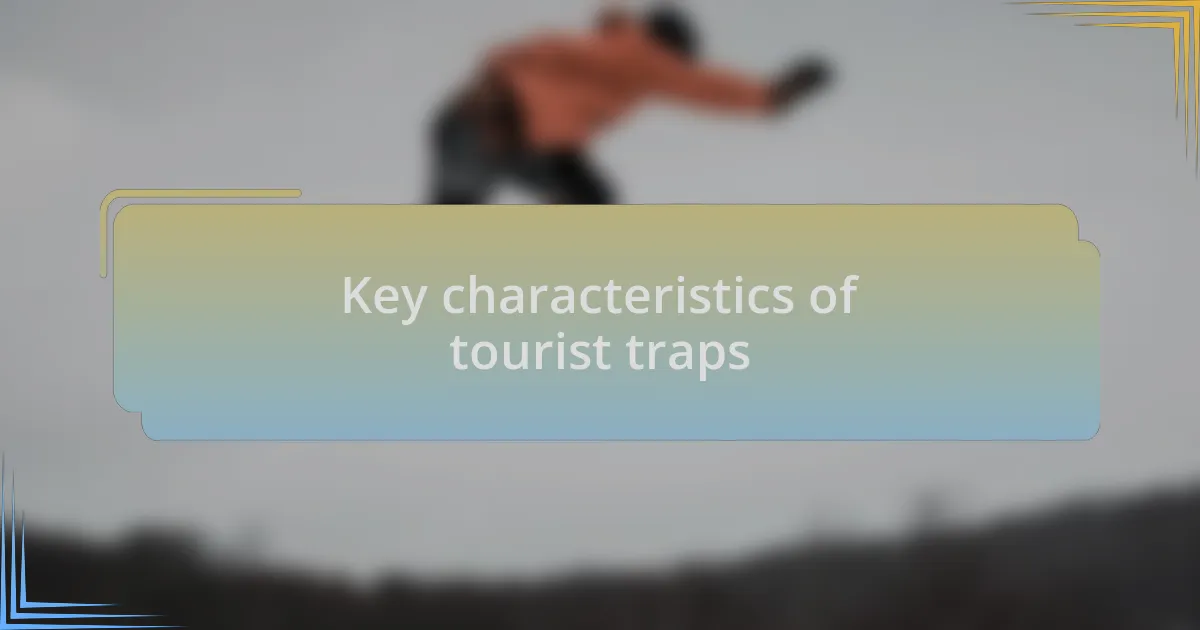
Key characteristics of tourist traps
When exploring a new destination, tourist traps often exhibit a few defining characteristics that can alert savvy travelers. For instance, high-pressure sales tactics in overly crowded areas are a telltale sign. I experienced this firsthand at a popular market where vendors overwhelmed me with loud, aggressive pitches. Instead of enticing me with genuine cultural experiences, it felt as if I was being pushed into buying anything just to escape the chaos. Have you ever felt pressured like that? It’s unsettling, right?
Another common trait is the homogenization of experiences. Tourist traps typically offer a watered-down version of local culture that caters to mass appeal. During one trip, I wandered into a restaurant that boasted “authentic local cuisine” but served up a bland, generic dish far removed from its cultural roots. I couldn’t help but wonder who does this really serve? It’s disappointing when what’s marketed as “authentic” turns out to be more of a manufactured experience than a true taste of the place.
Lastly, exorbitantly high prices for items or experiences that lack intrinsic value signal a tourist trap. I recall visiting a famous attraction where the entry fee was shockingly steep, yet inside were only overcrowded rooms and poorly maintained exhibits. If only I had ventured to a lesser-known site nearby, where the cost was minimal, but the purity of history and craftsmanship made all the difference. Why settle for less when there are hidden gems to discover that offer true value?
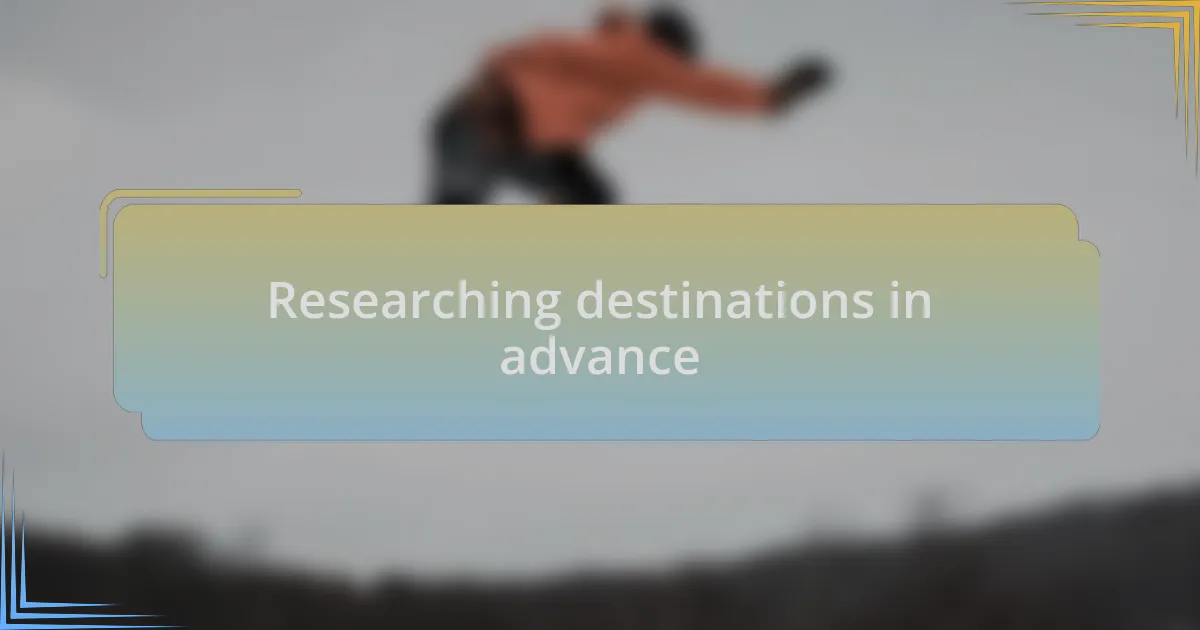
Researching destinations in advance
Before embarking on your trip, take the time to thoroughly research your destination. I remember planning a spa getaway where I spent hours comparing reviews, checking travel forums, and exploring local blogs. This preparation not only helped me find a serene resort off the beaten path but also revealed hidden wellness experiences that tourists often overlook. What if I had simply booked the first option I saw? It would have cost me some unforgettable moments.
Utilizing social media can be a powerful tool for research as well. I often scroll through Instagram or use hashtags related to my destination to find authentic experiences. Once, I discovered a small, family-owned spa that wasn’t featured in any travel guides. The treatments were exceptional, and unlike anything I had ever experienced. It made me ponder, how many hidden gems are waiting to be found if I just dig a little deeper?
Lastly, I suggest looking into local events or festivals that may be happening during your stay. When I traveled to a lush spa in the mountains, I unknowingly timed my visit with a traditional wellness festival. The organic workshops and local crafts enriched my experience beyond comparison. Imagine inadvertently missing such an enriching opportunity due to lack of research. The deeper you go into your homework, the richer your travel experience becomes.
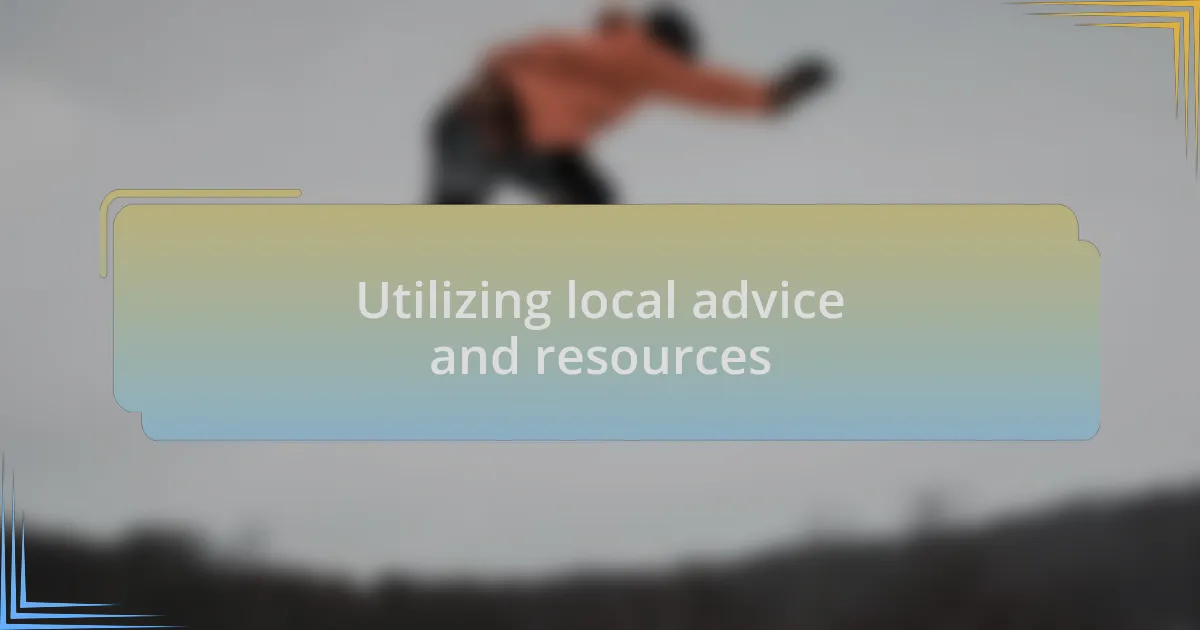
Utilizing local advice and resources
I find that chatting with locals can be one of my best strategies for uncovering authentic experiences. During a trip to a coastal spa, I struck up a conversation with a friendly barista who shared his favorite hidden beaches and local eateries. Those recommendations led me to a tranquil spot that tourists typically miss, and I felt a sense of connection to the area that standard travel guides just couldn’t offer. Have you ever experienced the thrill of discovering a place through local eyes?
When it comes to utilizing local resources, I’ve learned the value of asking for recommendations straight from my spa or hotel staff. On a recent visit to a wellness resort, I was advised to explore a lesser-known hiking trail nearby. The path wasn’t just beautiful; it was a transformative experience that provided a unique perspective of the surroundings. How often do we overlook the expertise right at our fingertips?
Lastly, joining local forums or community groups online can be incredibly beneficial. I remember being part of a Facebook group dedicated to wellness travel, where members regularly shared tips and lesser-known wellness spots. Through a simple post, I discovered an up-and-coming spa that offered innovative therapies, something I would likely have missed otherwise. Isn’t it fascinating how a little engagement with the local community can open up a world of possibilities?

Tips for spotting tourist traps
When wandering through popular destinations, I’ve learned to observe the crowd. If a place is bustling with tourists, it might be a signal to tread carefully. I vividly recall a time in a vibrant market where the stalls were packed; I decided to bypass it, seeking out quieter corners instead. Sometimes, the best finds lie off the beaten path, don’t you think?
Another tactic I employ is to watch for consistency. If a restaurant or shop is advertising the “best” this or that but lacks genuine reviews from locals, I become skeptical. I once stumbled upon a café boasting rave reviews that felt a bit too scripted, and after trying it, the dish disappointingly fell flat. Have you ever felt that disconnect between expectation and reality?
I also pay attention to pricing. If something seems excessively expensive for what’s offered, I take a moment to step back. On a recent trip, I encountered a spa that charged a premium for treatments with little actual value behind them. I learned to trust my instincts, leading me to more reasonable options that provided far superior experiences. Doesn’t it feel empowering to make choices based on authenticity rather than allure?
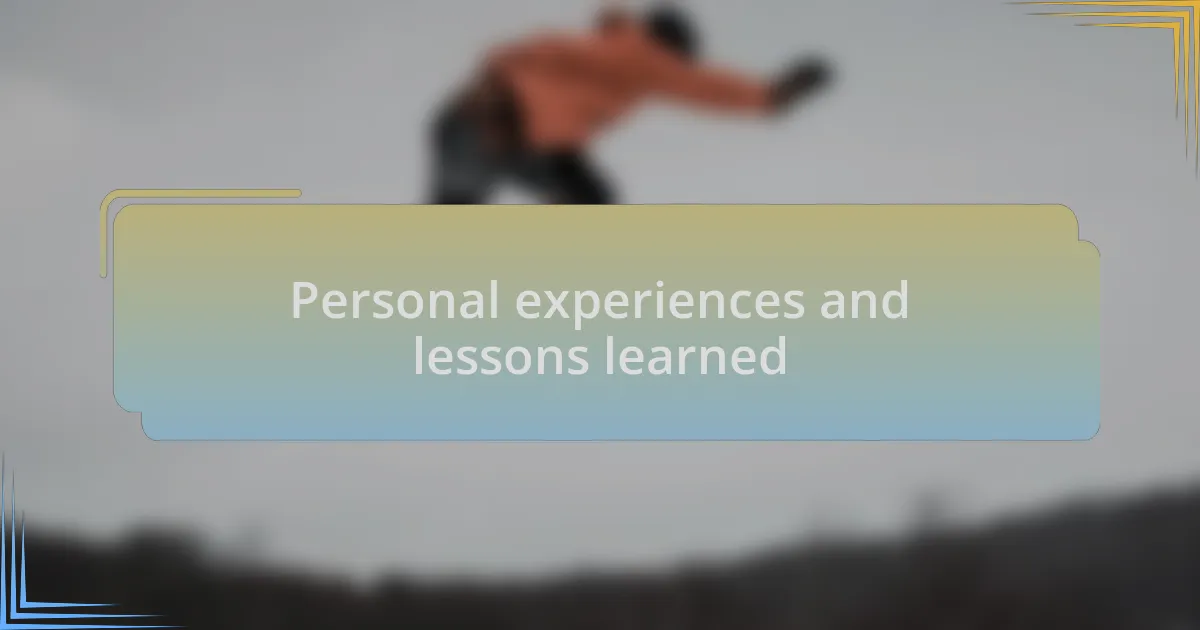
Personal experiences and lessons learned
I remember visiting a historic city known for its beautiful architecture, only to find myself surrounded by tour groups snap-chatting every moment. Feeling the pressure of the crowd, I wandered into an unassuming little plaza nearby. The tranquility offered me a local café that served the most exquisite pastries, showing me that sometimes, the path less traveled can lead to delightful surprises.
Reflecting on my experiences, I’ve learned the value of listening to locals. One time, a friendly resident shared hidden gems that weren’t in any travel guide. Their recommendations led me to a family-owned spa that provided treatments rooted in traditional practices, which felt authentic and nurturing. Have you ever asked a local for tips and felt that sense of connection? It can truly transform your journey.
Budgeting is another crucial lesson I’ve taken to heart. There was a time I splurged on a popular resort, drawn in by glossy ads and flashy promotions, but the experience ultimately fell flat. I realized I had sacrificed quality for the illusion of luxury. This taught me that real value lies in genuine experiences, not just price tags—but haven’t we all learned this lesson the hard way at some point?